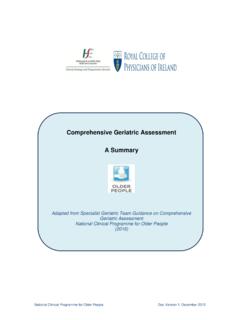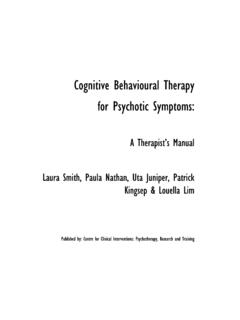Transcription of LSVT BIG - Subacute Care
1 Paula McGinley Senior Occupational Therapist LSVT BIG LEARNING OBJECTIVES Have an understanding of: What is LSVT BIG How LSVT BIG differs from traditional PD therapy approach Importance of skill acquisition and activity dependent neuroplasticity in rehabilitation How you can apply the principles of activity driven neuroplasticity in daily clinical practice to benefit PWP WHAT IS LSVT BIG? An intensive, whole body, amplitude-focused, evidenced-based treatment protocol for adults with Parkinson s disease LSVT Global, Inc LSVT BIG BACKGROUND Hypothesis-based/Parkinson s specific Derived from LSVT LOUD developed 1987 Neuroplasticity based Forced exercise results in neuroprotective effects and improved motor function Vigorous exercise may modify disease progression Early exercise resulted in no behavioural impairment and attenuated dopamine loss Identified fundamental principles of neuroplasticity Identified key principles of exercise that can drive activity-dependent neuroplasticity Research based LSVT BIG developed 2010 Researched
2 Extensively Based on the principles of activity dependent neuroplasticity WHAT IS ACTIVITY (EXERCISE) DEPENDENT NEUROPLASTICITY? Modifications within the central nervous system in response to physical activity that promotes a skill acquisition process. As such; intensity, specificity, difficulty and complexity of practice appear to be the important parameters for driving neuroplasticity and potential lasting effect on both brain and behavior Enhancing neuroplasticity in the basal ganglia: The role of exercise in PD Giselle et al.
3 Mov Disord, 2010; 25(01); S141-S145 SKILL ACQUISITION & MOTOR LEARNING 3 stages: cognitive stage developing an understanding of the skill Associative Stage learner demonstrates more refined movement through practice Autonomous stage The motor skill is mostly automatic = skill acquisition FORCED AEROBIC EXERCISE & SKILLED ACQUISITION TRAINING- LSVT BIG The Berlin LSVT BIG Study 1:1 LSVT BIG (BIG) vs group nordic walk training (WALK) vs non-supervised exercises (HOME). - 60 pts mild-mod PD randomly assigned to a group - significant differences in UPDRs final score.
4 - superior to both groups - significant improvement in TUG, UPDRS, and 10 MWT -spread of effects -LSVT maintained at 16wks - effective technique to improve motor performance in PD Ebersbach et al. Movement Disord (2010) 2nd study same cohorts- impact of LSVT BIG on reaction time -supervised movement therapy cognitive aspects of exercise - readiness to go - Improved cued reaction time Ebersbach et al. Arch Phys Rehabil (2013) LSVT BIG vs traditional outpatient physical therapy -achieved bigger, faster steps - velocity when walking - results maintained 3 months post program Farley & Koshland (2013) randomised Comparative Pilot Study Unpublished data LSVT BIG BENEFITS NON MOTOR SYMPTOMS OF PD statistically significant improvements in; -UPDRS -Beck Depression Inventory -Modified Fatigue Impact Scale Exercise also benefited the control non PD group Dashtipour et al.
5 (2015) FOR PWP TO IMPROVE Use it or lose it Use it and Improve it Specificity Repetition matters Intensity matters Time matters Salience matters Age matters Generalisation matters Intensity/forced effort specificity difficulty complexity of practice Barriers- Mood, cognition, lack of carer support, transport, age, apathy and disease severity Inactivity produces degeneration generally PWP least active at diagnosis Neuroplasticity Activity dependent neuroplasticity TRADITIONAL PD THERAPY VS LSVT BIG Low to medium intensity Compensatory focused No treatments of sensory impairments Avoid multitasking during adls Using cues to initiate and maintain movements Divide complex movements into a series of simpler components of the overall task; execute sequentially Van der Mark et al.
6 Parkinsonism & related disorders (2009) High intensity & high effort Specificity-1 treatment target of amplitude across motor systems Difficulty-dual task train Relearn a new internal cue for amplitude scaling Complexity-do not break down tasks Calibrate effort into all occupations for longer lasting effects (& not just during exercise) LSVT Global,Inc Traditional LSVT BIG LSVT BIG PARADIGM SHIFTS TARGET AMPLITUDE WHY? the largest range of motion that can be performed with the highest effort with the most maximally efficient biomechanics every trial/every day not random BIG but normal healthy movements MODE = INTENSIVE AND HIGH EFFORT WHY?
7 Intensive effort is needed to override bradykinesia and hypokinesia Increases muscle activation Arouses the sensorimotor system- kinesthetic and proprioceptive change SENSORY CALIBRATION= GENERALISATION WHY? PWP learns and accepts the amount of effort needed to consistently produce bigger movements PWP learns the relationship between increased movement effort and established movement output PWP learns how to generalize/carry over this effort into everyday occupations If you don t feel like you are moving Too BIG You are not moving BIG enough!
8 LSVT GLOBAL, INC INTENSITY: STANDARDISED Dosage with Therapist: 1:1 4 consecutive days a week for 4 weeks 16 sessions in one month Dosage for PWP: 2 sessions 7 consecutive days a week for 4 weeks 30 sessions Repetitions: minimum 8-16 repetitions each exercise Minimum 5 repetitions each functional component Effort: push for maximum patient-perceived effort each day Aim for 8-9 on a scale of 1-10 with 10 being the max LSVT Global, Inc PROTOCOL-LSVT BIG TREATMENT SESSION* Maximal daily exercises to ceiling 8 reps to side-8 reps each side step-8 reps each side step-8 reps per side step-8 reps per side step- 8 reps per side Also seated and supine variations available * Disclaimer: LSVT BIG protocol should only be delivered by a certified OT or Physio.
9 LSVT Global, Inc Functional Component tasks; x 5 reps - dressing buttoning -transferring low chair -work tasks typing -writing signature -cooking moving/turning Walking BIG -Distance and time may vary Hierarchy tasks -Go to the cinema -Dress independently top and lower half Build complexity over 4 weeks Carryover tasks CASE STUDY MR D 73 year old male Idiopathic Parkinson s disease diagnosed 2008 Hoehn and Yahr scale stage 2 Mild bradykinesia and dystonia left UL and LL Kinson 100/25mg 1&1/2 tabs QID Lives with wife.
10 No services Independent mobility no aids 2 x falls tripping up over kerb-reduced clearance left foot Independent with shower, drying and grooming Requiring frequent assistance with putting shirts/jackets, fastening buttons and zips MR D S GOALS BIG walk Sit to stand Handwriting Getting coins out of his wallet Rolling in bed Getting a long sleeve top on and off Being able to get up from a chair, walk to the toilet and be able to unfasten his trousers and adjust underwear in time Functional Components Hierarchy Task MR D S CARRYOVER TASKS Big walk Sit to stand Handwriting Getting coins out of his wallet Rolling in bed Getting a long sleeve top on and off Walk to the shops every day Stand up from chair in restaurant Write card for wife + shopping list Pay for morning newspaper Roll over in bed and manage to adjust the covers Dress independently Exercise 1 Floor to Ceiling Maximum sustained movments- seated




